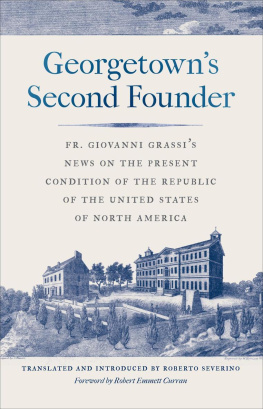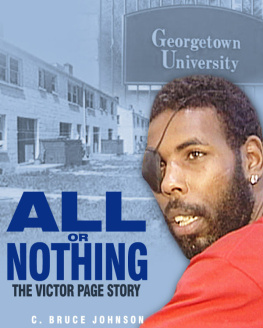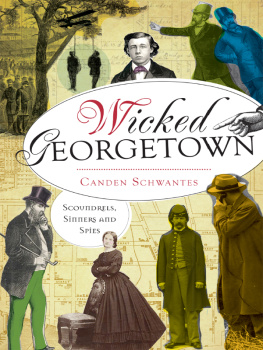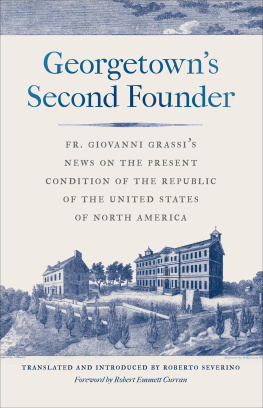
The Campus History Series
GEORGETOWN UNIVERSITY

Surrounded by farmland, the Georgetown campus appears in the distance in this c. 1831 painting. Although it was the nations capital, Washington remained a small town with few major improvements; a place that Charles Dickens described in 1842 as a city with spacious avenues, that begin in nothing, and lead nowhere. That changed dramatically after the Civil War when the federal government expanded, streets were paved, sewers installed, and landmarks like the Capitol dome and Washington Monument were completed. (Georgetown University Booth Family Center for Special Collections.)
FRONT COVER: Construction of Healy Hall was completed 20 years before this c. 1900 photograph. Described as Patrick F. Healy, SJs, far-flung gesture of confidence and resolve about Georgetowns future, Healy Hall is the iconic emblem of Georgetown University. (Georgetown University Booth Family Center for Special Collections.)
COVER BACKGROUND: Georgetown football players pose in front of Healy Hall around 1900. A football association began at Georgetown in 1874; the first team was formed in 1883. (Georgetown University Booth Family Center for Special Collections.)
The Campus History Series
GEORGETOWN UNIVERSITY
PAUL R. ONEILL AND BENNIE L. SMITH

Copyright 2020 by Paul R. ONeill and Bennie L. Smith
ISBN 978-1-4671-0466-1
Ebook ISBN 978-1-4396-6958-7
Published by Arcadia Publishing
Charleston, South Carolina
Library of Congress Control Number: 2019954205
For all general information, please contact Arcadia Publishing:
Telephone 843-853-2070
Fax 843-853-0044
E-mail
For customer service and orders:
Toll-Free 1-888-313-2665
Visit us on the Internet at www.arcadiapublishing.com
This book is dedicated to the women and men who, for more than 200 years, have been a part of Georgetown Universitys academic community in the Jesuit tradition of creating and communicating knowledge and living in service to others.
CONTENTS
ACKNOWLEDGMENTS
Those who have studied the history of Georgetown University know the indispensable resource, Dr. Emmett Currans three-volume A History of Georgetown University. Dr. Currans books provide a definitive understanding of the university from its founding to the modern era. The authors of this book relied heavily on Dr. Currans research and scholarship, and we are deeply grateful to him.
The authors could not have completed this book without the expertise and guidance of university archivist Lynn Conway and assistant archivist Ann Galloway. Prof. John Glavin, PhD (C64), an expert in Georgetown architecture and history, shared essential feedback. Content, structure, and flow were thoroughly reviewed by Deirdre Kenny (C86). Feedback and edits were provided by Gregory Annick (C86), Deborah Cunningham, Caroline Knickerbocker (S15), and Judy Pezza Rasetti (G97). Unless otherwise noted, the images in this book are from Georgetown Universitys Booth Family Center for Special Collections.
A letter and date follow the names of alumni to designate the Georgetown school they attended and their year of graduation:
| B | McDonough School of Business |
| C | Georgetown College |
| F | School of Foreign Service |
| G | Graduate School |
| I | Institute of Languages and Linguistics |
| L | Law Center |
| LLM | Master of Laws |
| M | Medical School |
| N | School of Nursing and Health Studies |
| S | School of Continuing Studies |
INTRODUCTION
We shall begin the building of our Academy this summer, wrote John Carroll, SJ, in March 1788, referring to the construction of Old South, the first campus building of Georgetown University, the oldest Catholic and Jesuit university in the United States.
Georgetown University marks 1789 as the year of its founding. But few know that a mid-19th-century typographical error factors centrally in the history of Georgetowns founding date. Historian Emmett Curran discovered that for more than 50 years, Georgetown linked its beginning to 1788, the year that construction began on the first campus building, Old South. However, the 1851 college catalog incorrectly listed 1789 as the year that construction began. The 1873 catalog repeated the dating error and added another, stating for the first time that Georgetown was founded as a College in 1789. The discrepancy was discovered some time after the university celebrated its centennial in 1889. So, when the error came to light, why didnt the university return to 1788 as the founding yearthe year originally cited, the year the first building was started? Likely, university leaders were reluctant to compromise the romantic association with 1789, the year of George Washingtons inauguration and the year the first US Congress met under the new Constitution. After all, they reasoned, 1789 was the year that John Carroll obtained the deed for the first parcel of campus land.
Founding a college in late-18th-century America was not an unusual undertaking. As Curran chronicled in A History of Georgetown University, 23 American colleges began between 1782 and 1800. What was unusual about Carrolls venture was that he was establishing a school without the guarantee of church or state funding, or the benefit of a private endowment.
Carrolls vision for Georgetown anticipated the importance of endowments. He believed that Catholic laity would provide considerable subscriptions in support of his venture. In his Proposals for Establishing an Academy at George Town, Patowmack-River, Maryland dated November 1786, Carroll outlined the purpose of the new school, writing that a system [would] be effectually carried into existence that would eliminate or substantially reduce the need to charge tuition to run the school.
Carroll sent copies of his Proposals with a one-page solicitation to elite Catholics in the United States and Europe. The solicitation was addressed To all liberally inclined to support the education of youth and asked for generous donations for the purposes set forth in the Proposals. In fact, Carroll received no substantial pledges of financial support for the new school, either in response to his initial outreach or the several campaigns that followed. As historian Joseph T. Durkin, SJ, put it: Georgetown committed herself to becoming a university on a total average income (from all sources) of less than $150,000 a year.
The absence of a founding endowment would have lasting effect. Georgetowns financial concerns, wrote the editor of Georgetown magazine in 1982, are older than the University itself, and capital, or lack of it, is inextricably linked to the events that form the history of [Georgetown University].
Despite an inextricable link with insufficient capital, Georgetown rose to national and international prominence in higher education. Its success can be attributed in part to the leadership of several visionary men, referred to in their day as Georgetowns founders, who built on Carrolls original vision. Patrick F. Healy, SJ, president from 1873 to 1882, is universally considered to be Georgetowns second founder. Timothy S. Healy, SJ, president from 1976 to 1989, is referred to in modern times as Georgetowns third founder. Between the two Healys there were other consequential presidentsW. Coleman Nevils, SJ, for example, and Edward Bunn, SJ, who were each referred to historically as a Georgetown founder. Inspired by the leadership and impact of these men, the content of this book is ordered around their tenure as presidents.
Next page








